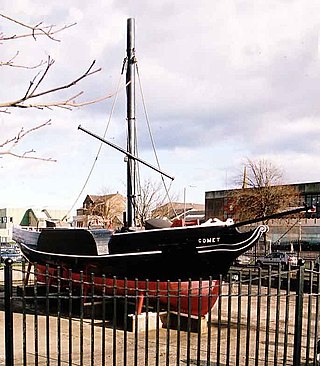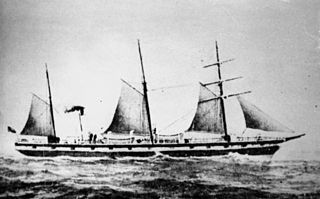
SS Yongala was a passenger steamship that was built in England in 1903 for the Adelaide Steamship Company. She sank in a cyclone off the coast of Queensland in 1911, with the loss of all 122 passengers and crew aboard.

HMS A1 was the Royal Navy's first British-designed submarine, and their first to suffer fatal casualties.

The PSComet was built in 1812 for Henry Bell, a Scottish engineer who with his wife had become proprietor of the Baths Hotel offering sea bathing in Helensburgh. On 15 August 1812, Bell's ship began a passenger service on the River Clyde, connecting Helensburgh to Greenock and Glasgow. This was the first commercially successful steamboat service in Europe. Bell obtained the engine from John Robertson of Glasgow, and the ship was built for him by John and Charles Wood of Port Glasgow.

The Clyde puffer is a type of small coal-fired and single-masted cargo ship, built mainly on the Forth and Clyde canal, which provided a vital supply link around the west coast and Hebrides of Scotland.

HMS K13 was a steam-propelled First World War K class submarine of the Royal Navy. She sank in a fatal accident during sea trials in early 1917 and was salvaged and recommissioned as HMS K22.

HMS Resolution was a 70-gun third-rate ship of the line of the Royal Navy, launched at Harwich Dockyard on 6 December 1667. She was one of only three third-rate vessels designed and built by the noted maritime architect Sir Anthony Deane.

Mensun Bound is a British maritime archaeologist born in Stanley, Falkland Islands. He is best known as director of exploration for two expeditions to the Weddell Sea which led to the rediscovery of the Endurance, in which Sir Ernest Shackleton and a crew of 27 men sailed for the Antarctic on the 1914–1917 Imperial Trans-Antarctic Expedition. The ship sank after being crushed by the ice on 21 November 1915. It was rediscovered by the Endurance22 expedition on 5 March 2022.

HMS Buffalo was a storeship of the Royal Navy, originally built and launched at Sulkea, opposite Calcutta, in 1813 as the merchant vessel Hindostan. The Admiralty purchased her that year after she arrived in Britain. She later transported convicts and immigrants to Australia, before being wrecked in 1840.

RMS Campania was a British ocean liner owned by the Cunard Line, built by Fairfield Shipbuilding and Engineering Company of Govan, Scotland, and launched on Thursday, 8 September 1892.
The Diamond was a three-masted square rigger, built in New York City in 1823. She was one of the first ships to operate a regular service for passenger and cargo between Britain and the United States. She sank en route to Liverpool from New York on 2 January 1825 in Cardigan Bay. The alleged wreck site was identified in 2000 and was designated under the Protection of Wrecks Act 1973 on 1 April 2002, the first such designation by the National Assembly for Wales. However, the identification has since been called into question.

HMS Montagu was a Duncan-class pre-dreadnought battleship of the British Royal Navy. Built to counter a group of fast Russian battleships, Montagu and her sister ships were capable of steaming at 19 knots, making them the fastest battleships in the world. The Duncan-class battleships were armed with a main battery of four 12-inch (305 mm) guns and they were broadly similar to the London-class battleships, though of a slightly reduced displacement and thinner armour layout. As such, they reflected a development of the lighter second-class ships of the Canopus-class battleship. Montagu was built between her keel laying in November 1899 and her completion in July 1903. The ship had a brief career, serving for two years in the Mediterranean Fleet before transferring to the Channel Fleet in early 1905. During wireless telegraphy experiments in May 1906, she ran aground off Lundy Island. Repeated attempts to refloat the ship failed, and she proved to be a total loss. She was ultimately broken up in situ.

SS Gothenburg was an iron-hulled sail- and steamship that was built in England in 1854 and sailed between England and Sweden until 1862. She then moved to Australia, where she operated across the Tasman Sea to and from New Zealand until 1873, when she was rebuilt. After her rebuild, she operated in the Australian coastal trade.

PS Portland was a large side-wheel paddle steamer, an ocean-going steamship with side-mounted paddlewheels. She was built in 1889 for passenger service between Boston, Massachusetts, and Portland, Maine. She is best known as the namesake of the infamous Portland Gale of 1898, a massive blizzard that struck coastal New England, claiming the lives of over 400 people and more than 150 vessels.

The Henry Chisholm was a wooden freighter that sank off the shore of Isle Royale in Lake Superior in 1898 and the remains are still on the lake bottom. The wreck was placed on the National Register of Historic Places in 1984.

SS Monarch was a passenger-package freighter built in 1890 that operated on the Great Lakes. She was sunk off the shore of Isle Royale in Lake Superior in 1906 and the remains of her wreck and cargo are still on the lake bottom. The wreck was placed on the National Register of Historic Places in 1984.

TS King George V was a pioneering Clyde passenger turbine steamer, built in 1926. She was a popular boat, seeing service to Inveraray and later based in Oban, and withdrawn in 1974.

PS Iona was a MacBrayne paddle steamer, which operated on the Clyde for 72 years, the longest-serving Clyde steamer.

SS Arratoon Apcar was an iron-hulled sail and steam merchant ship that was built in Scotland in 1861 and wrecked off the coast of Florida in 1878. Her wreck in shallow water on Fowey Rocks is now a scuba diving site.
The Gull Rock Wreck was discovered off Gull Rock, Lundy Island, England in 1968. The site was designated under the Protection of Wrecks Act on 12 February 1990. The wreck is a Protected Wreck managed by Historic England.

Robert C. Pringle, originally named Chequamegon, was a wooden-hulled American tugboat that sank without loss of life on Lake Michigan, near Sheboygan, Wisconsin, on June 19, 1922, after striking an obstruction.


















